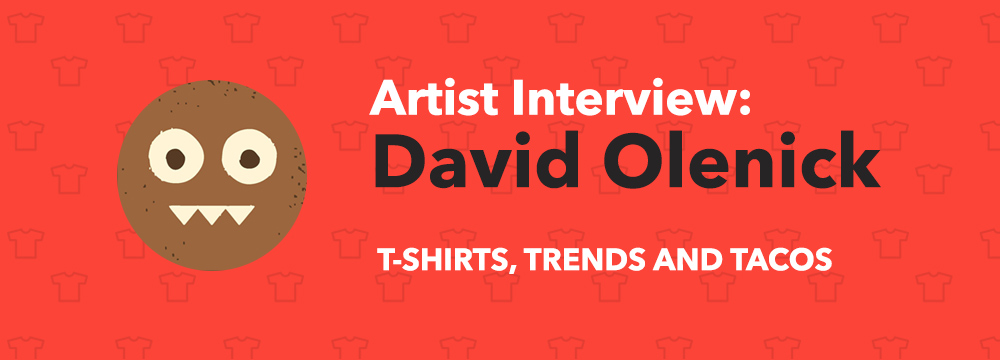
From Print-On-Demand To Brick & Mortar: An Interview With Illustrator David Olenick
by Michael Essek · Updated: March 7, 2020There aren’t many T-Shirt designers whose work is as recognisable as that of David Olenick.
David is a T-Shirt OG – and his quirky, pun-heavy designs have been a hit across multiple platforms and products since he started submitting to Threadless in 2012.
In this interview David spills the beans on his journey and his methods – whilst sharing a wealth of advice for aspiring artists – plus some of his predictions for the future of our industry.
Enjoy!
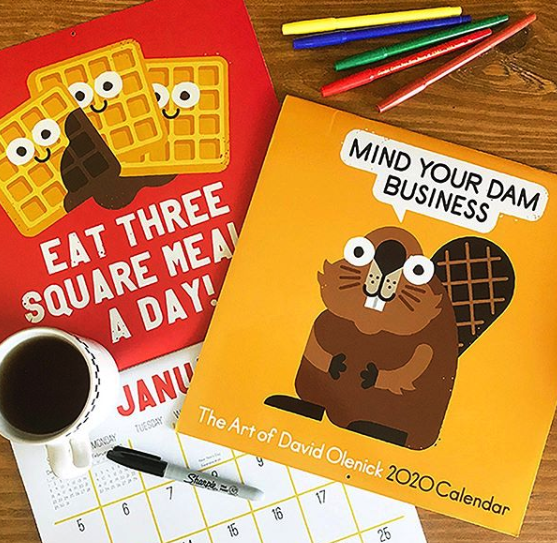
The Art Of David Olenick 2020 Calendar
Q: Can you give us an intro to yourself – where you’re from, how long you have been designing funny stuff, and how you got started?
Yes, I grew up in a suburb of Washington DC, and moved to NYC for college, where I’ve been for most of my adult life.
I was pretty serious about drawing, design & humor from a young age, but it wasn’t until art school (Parsons School of Design) that I started focusing on doing funny art.
That was abruptly put on hold for about 15 years while I pursued a career in fashion – creating art for apparel as a staff designer, and then as an art director, at places like Tommy Hilfiger & Macy’s. During that time I did almost zero personal work – I didn’t even keep a sketchbook.
When my last fashion job ended in 2011, I re-connected with my college self & started doing personal work again, which is now what I do full time.
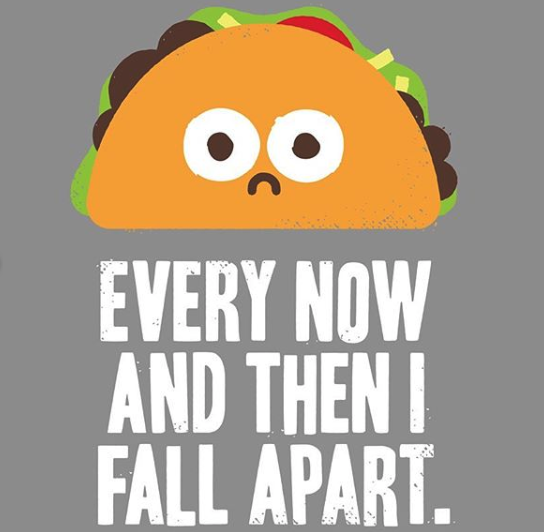
“Taco Eclipse Of The Heart” by David Olencik
Q: When did your “personal work” turn into a full-time job for you? and how many years did that take?
I never really made a conscious decision to go out on my own.
When my last fashion job ended, I had a severance package and some savings, so I just decided to take some time off for the first time ever. I was thinking maybe 3 months and I’ll look for another job, but I found myself very resistant to going back.
I downsized my apartment and other expenses, and took about a year and a half to clear my head. By that time, I’d organically started doing art again. It was similar to what I’d done in art school, but with the added benefit of 15 years of design experience.
This was around 2012, and I started submitting my designs to Threadless, where they started to do well pretty quickly. Threadless seemed to take a liking to my work and really put out it out there for people to see. I also started a Society6 shop.
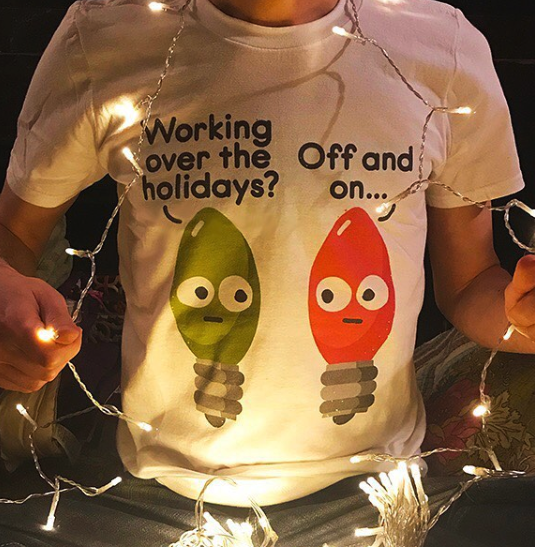
“Seasonal Employment” By David Olenick
The Fan brothers, who were Threadless colleagues and not yet children’s book stars at that point, gave me some advice about actively engaging with Society6 to build followers & then sales, and soon I had some income coming in from both Threadless and Society6.
The exposure from those 2 sites (especially Threadless) plus a few modestly viral moments led to a number of major companies reaching out to me for licensing, and by around 2013 I had enough income from licensing to support myself.
Q: Can you tell us about your creative process – how you come up with ideas, and how you go about turning them into finished designs?
I always carry a pocket sketchbook, and I’ve trained myself to write down/sketch the usable funny things I say or think in real time.
Sometimes I brainstorm with my girlfriend over drinks to generate ideas, but mostly ideas happen organically in the course of daily living. This gives me a large backlog of ideas, and I just choose from the list whichever one I’m most excited to draw at the moment.
Early on, I usually went from rough sketch directly to Adobe Illustrator, but now I prefer to start refining the shapes with pencil and tracing paper, and scan a fairly complete sketch to re-create in Illustrator. That added “by-hand” step actually makes things faster and more efficient in my case.
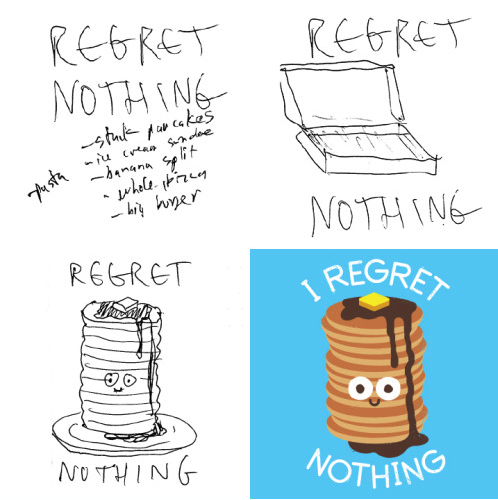
“Carbe Diem” By David Olenick
My designs are always rooted in geometry, so Adobe Illustrator is the best way to build them. But I do take a lot of care to create a subtly organic finish for my drawings, using techniques that evoke distressing & printing imperfections inspired by the pre-digital era. This step also helps me capture/translate the charm of my initial rough sketches, which I always have in mind.
Another important aspect of my process is that my typography is planned, sketched and refined from the beginning, right along with the drawing, and not as an afterthought. No distinction is made between letters and any other shapes, which I believe is a key to good typography.
Q: How often do you create new designs – and how many designs do you currently have in your catalog?
For years I’ve been working at the glacial pace of 2 new designs per month on average (doubled it this past 2 months though!), and I have somewhere between 150 and 200 designs in my catalog.
I’m less prolific than many of my peers, perhaps even to my financial detriment, but I prefer a slower pace for a few reasons;
- One, I believe that designs can get lost in the shuffle if you’re dropping too many too fast. Each design I do is totally original and carefully crafted, and I want them all to have a moment in the sun & a chance to be seen/found.
- More importantly, while I’ve heard that a high volume of designs can translate into sales (at least in the POD world), I simply don’t want to do that. Not only because I believe it would lower the perceived value of each design, but because of what it would mean for my working process and quality of life.
My goal is not to make every possible cent I can, but instead to make a comfortable living doing only what I want, only when I want, while protecting my mental & physical health.
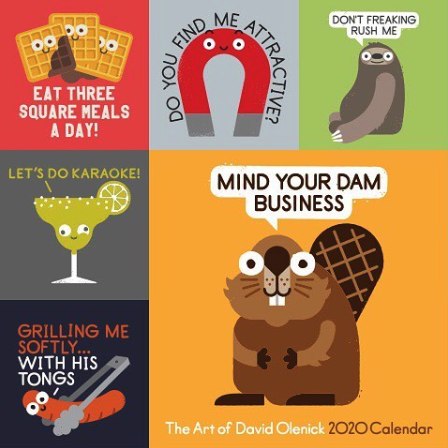
The Art Of David Olenick 2020 Calendar
Q: Do you try to design for certain topics and trends, or do you just create whatever you feel like creating?
I mostly just create what I feel like creating. I’m going for authentic, unique, evergreen designs that are trend-proof.
This isn’t a strategy (it’s just what makes sense to me artistically & creatively), but it does have a strategic advantage in that I’m still collecting significant royalties for the first few designs I ever did, which are around 7 years old. Each design I create can potentially earn me royalties forever, whereas “trend-right” art may only be valid while the trend is valid.
I followed and reacted to trends for 15 years in my former career in fashion, so I’m well versed in it, and I did find it to be an interesting creative challenge. In fact, I actually stay pretty aware of trends to this day, almost as a natural reflex. But I’m only interested in that information as a context for where my work fits in and stands out.
For instance, if I see that designs featuring sloths are trending, and I happen to have a sloth idea in my sketchbook, I’ll bump it to the top of my to-do list. But If don’t have a sloth idea in my sketchbook, I’m not gonna try to think of one one just because it’s trending, especially if I’m not interested in sloths (for the record, I am interested in sloths and have a sloth design in my library).
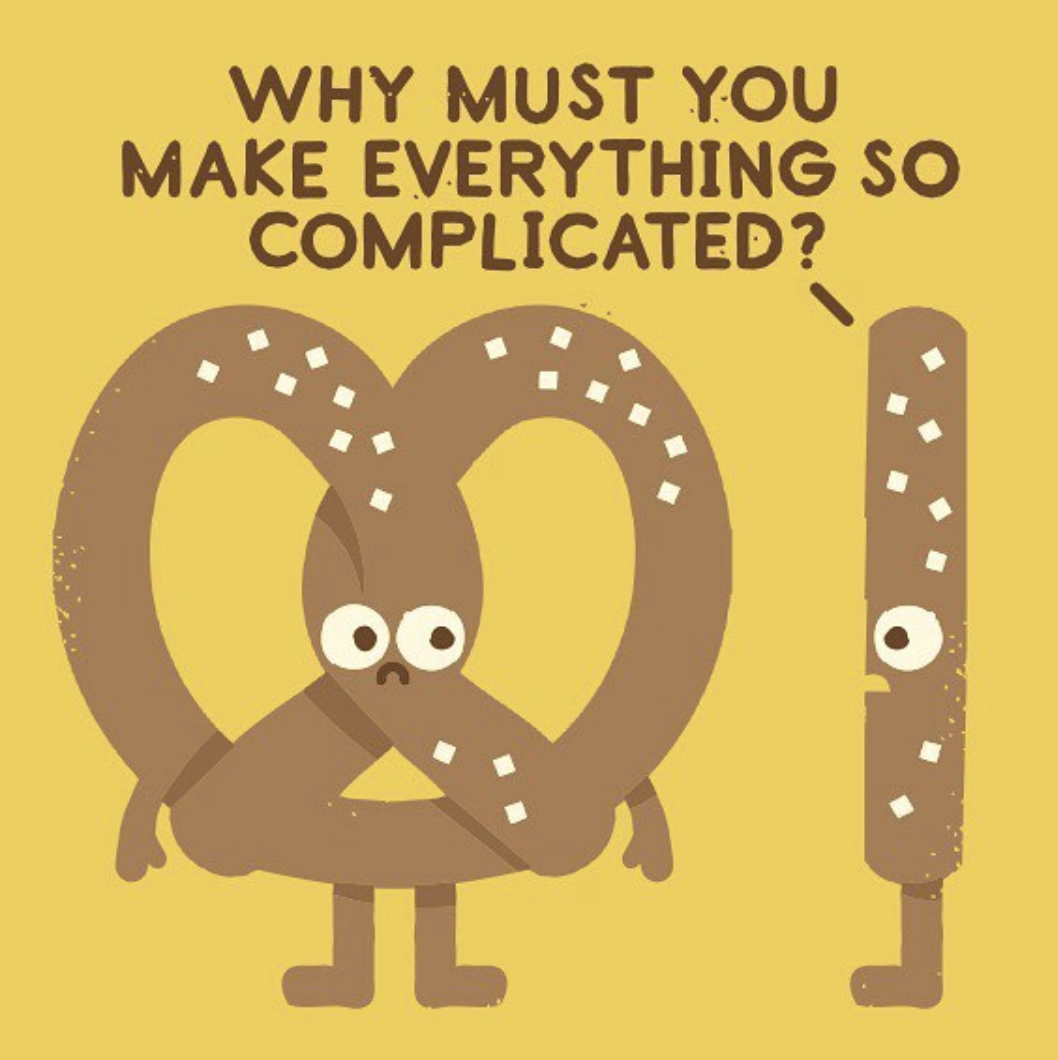
“Straight Talk” by David Olenick
There are exceptions. Once in a while a licensing partner will ask me to do “my thing” for a particular topic (such as Holidays) or a trend they’re doing well with. I decide whether or not to accommodate those requests on a case by case basis, but it’s not generally how I work.
Many people feel differently, but to me it makes no sense to be an independent artist and not express your own ideas & point of view.
Not to mention, too many people think that following trends means taking other people’s ideas and re-creating them. Done correctly, trend-right art should still be totally unique, only having the hallmarks of the trend in terms of color, subject matter, theme, etc.- and in my particular case, if I’m addressing a trend I prefer not only to do it uniquely, but to deconstruct, satirize, and even disrespect the trend. That makes it fun and true to who I am.
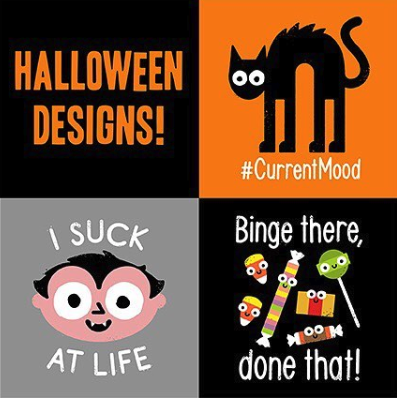
Halloween Designs by David Olenick
Q: When you sit down to create, do you try to design for certain products?
In most cases I don’t. The only exception is that certain ideas/designs lend themselves specifically to greeting cards, and that’s usually pretty clear at the idea/rough sketch stage.
Other than that, I think most of my ideas & jokes are pretty universal and translate well to multiple products. Many times a design works especially well on one product or another, but that’s usually an unintended byproduct.
That said, I’m probably unconsciously thinking of t-shirts & posters most of the time. They’re similar in that they benefit from standing out & reading quickly or at a distance, so they’re perfect vessels for my particular approach to design.
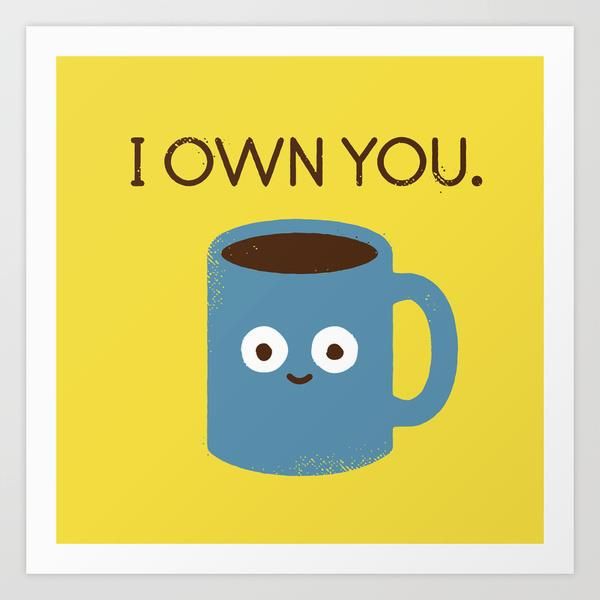
“Coffee Talk” By David Olenick – Poster
Q: Can you tell us a bit about the setup of your business – where you work, if you have any help, etc.?
I work from home, in a portion of my living room that serves as my studio. I just bought some beautiful reclaimed wood & black pipe work tables that I’m pretty excited about, so I have my vintage roll-top desk in front of me, an L-shaped work table situation behind me, and clothing racks, sample shelves, etc. on each side. I also use bars & restaurants to brainstorm & sketch over drinks.
I mostly work alone, but my girlfriend helps quite a bit, not only with brainstorming, but as a second pair of eyes for reviewing proofs & samples, and as extra (wo)manpower for time-consuming things like responding to copyright infringements.
I haven’t done an LLC or anything like that, because since I license my art to manufacturers (as opposed to making & selling products myself), I feel I have less risk of any liabilities.
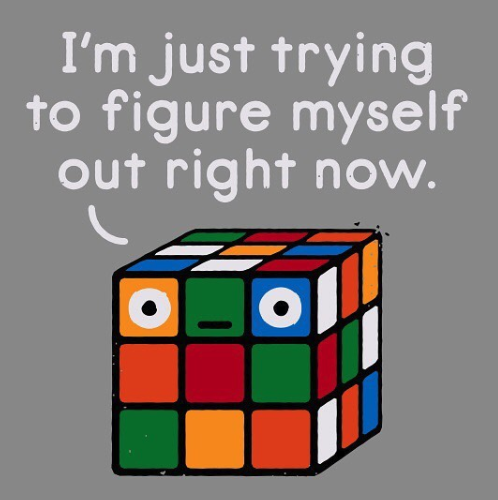
“Back To Square One” by David Olenick
Q: What are the biggest income generating sources for you – online platforms, offline licensing, commissions?
Pretty much all my income is from licensing and next to none is from commissions (which as I mentioned, I rarely accept).
These days, my biggest income sources are from things sold in brick & mortar stores – calendars, greeting cards, magnets, buttons and drinkware seem to be the best ones right now. But of course most of these licensees also offer the products online, so that factors in.
In previous years, online & POD were the biggest sources, but those have dipped a bit as the sheer number of choices for customers on those sites has grown exponentially.
I only participate in a handful of those sites, mostly concentrating on Threadless & Society6, but I’m working towards budgeting some time for a few others. Online/POD sales have always had an up & down pattern for me, but some of the brick & mortar stuff has been more reliable & consistent, slowly & steadily growing over time.
From most online/POD, tees & mugs are my best products.
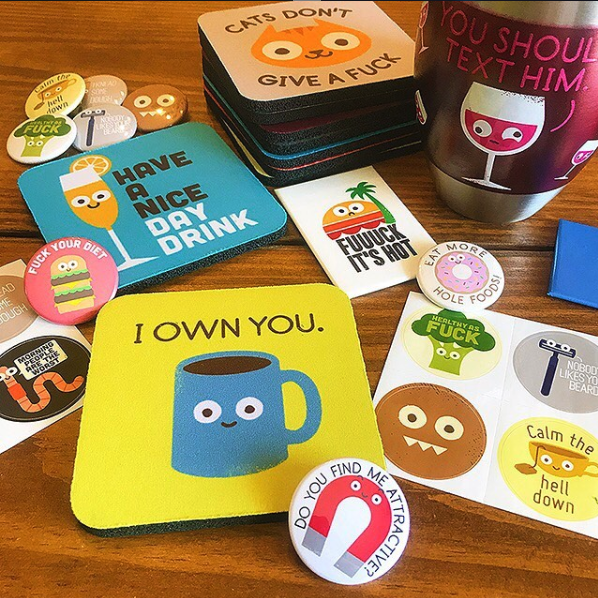
Q: You have a very recognisable yet simple graphic style. was it a conscious decision to develop this style, or did it just happen? do you ever feel limited by your style? what advice would you give artists who haven’t yet found their own ‘style’?
The look of my designs developed organically. I didn’t consciously seek to develop a style, but of course I was aware it was happening, and I worked to refine it.
It’s just how I naturally think, draw, & design. Simplicity, brevity, compositional harmony & a certain type of humor are probably an inevitable result of my individual personality & skill set.
So far I haven’t felt limited, partially because my work is so authentic to who I am, and partially because the work is always developing and being refined (though perhaps in ways that are too subtle or gradual to be noticed by a casual observer).
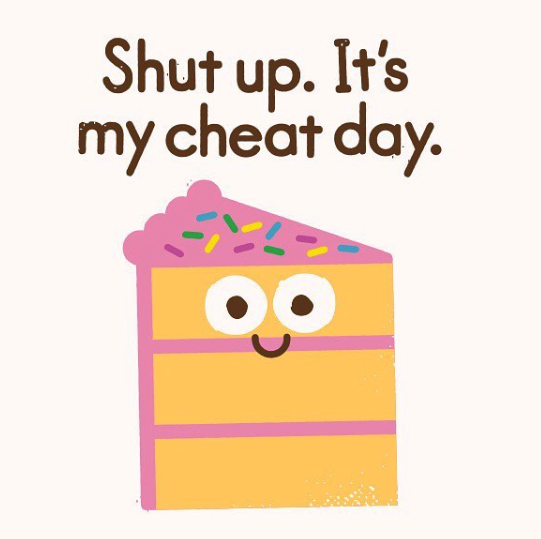
“Taking The Cake” by David Olenick
My advice to artists who haven’t yet found their own “style” would be, first, that there’s no law requiring that you have a definitive style. Some people work that way, but others enjoy being flexible. If you want a signature style, I don’t believe you can “find” it so much as you can get out of the way & let it emerge.
Don’t look to your peers’ work for a model. A style based on someone else’s art may fool a few people, especially if you’re a skilled artist, but the work people really respond to in a big way is usually an authentic personal expression.
Let yourself gravitate toward what moves you in any art form, so you can be inspired indirectly, and pull those elements out of yourself. At the time my art style was developing, I wasn’t looking at t-shirts, or even graphic artists, but instead I was at museums looking at ancient sculptures and abstract paintings.
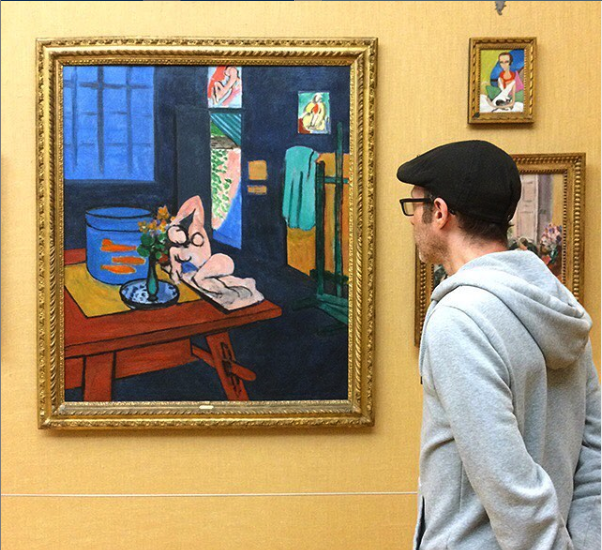
Q: Your work has been licensed for a lot of different uses – greeting cards, diaries, calendars etc. can you talk us through how those licensing deals came about?
Most of my licensing deals were simply someone at a company stumbling upon my work online & then reaching out by e-mail with an inquiry.
I did recently start working with an agent, so while I still get offers passively, now there’s someone actively seeking them for me as well, so I’m definitely adding more licenses faster these days.
Q: You’ve had some big hits – do you know what your all time bestselling design is?
I can probably narrow it down to 3 bestselling (and most stolen/copied/imitated) designs:

“Taco Eclipse Of The Heart” by David Olenick
- 1. “Taco Eclipse of the Heart” (Best product – T-shirts): I think this one does well because it has multiple appeals: the food itself, the double meaning, the mental health angle & the old song reference. It also has that nice, solid tombstone shape which looks great on products.
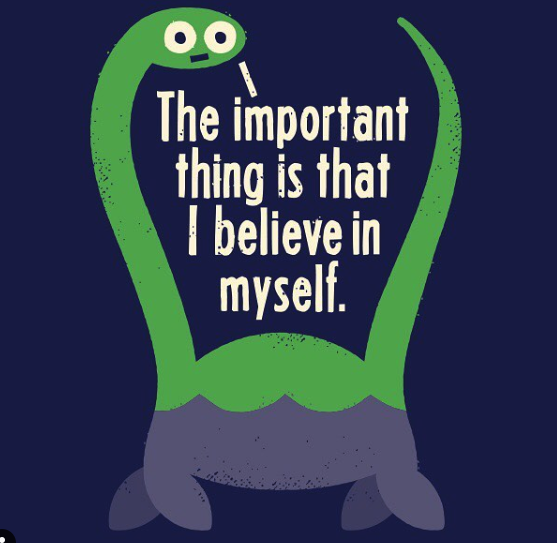
“Myth Understood” by David Olenick
- 2. “Myth Understood” (Best product – T-shirts): I always thought this worked because I wrote the message to be very conversational, which makes it both more relatable and funnier.
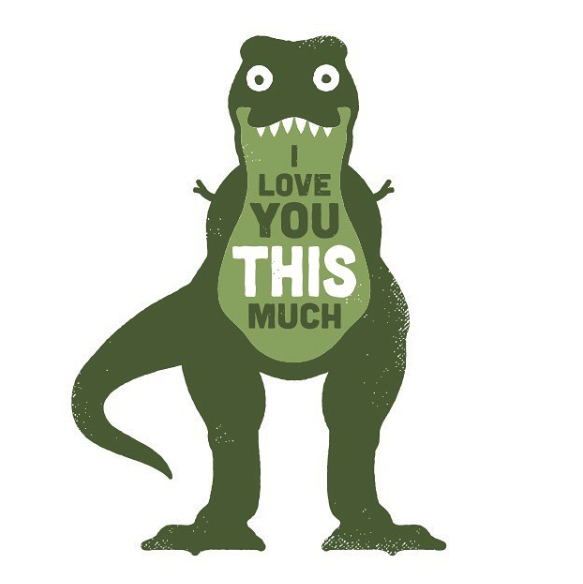
“Amourosaurus” By David Olenick
- 3. “Amourosaurus” (Best product – Greeting Cards): I think I maximised this joke by putting a lot of care into details like the scale of the arms vs. the body, and the goofy innocence of the facial expression. It’s a design that can elicit a genuine LOL the first time you see it.
I don’t think it’s an accident that my top 3 designs all have that funny/poignant combo. One of the lessons I learned in my fashion career was that eliciting an emotional response is a great way to motivate purchases, and 2 emotions is better than one.
Q: Your work must get copied and stolen a lot. How do you deal with that?
Yes, my work does get copied and stolen a lot. A LOT. It really would be impossible to overstate the scale of the problem. If I had a staff of 20 working on it full time, I still wouldn’t be able to address it all. And honestly, any time I do spend on it puts me into a state of absolute rage, which is not good for my health.
So I try to pick my battles, to limit the time I spend on such a loathsome task. I focus on infringements by larger companies and companies who appear to be generating significant revenue from the knockoffs.
I also focus on the most clear-cut infringements, since unfortunately the law is very limited in terms of what it protects. I prioritize those kinds of infringements and pursue them aggressively through a lawyer, who I work with on contingency, meaning they’re only paid from any award we get, and I don’t have to lay out any of my own money for it. This way I’ve been able to get several significant settlements, which in my mind make up for all the smaller infringements I have to ignore because the cost/benefit of pursuing them doesn’t make sense.
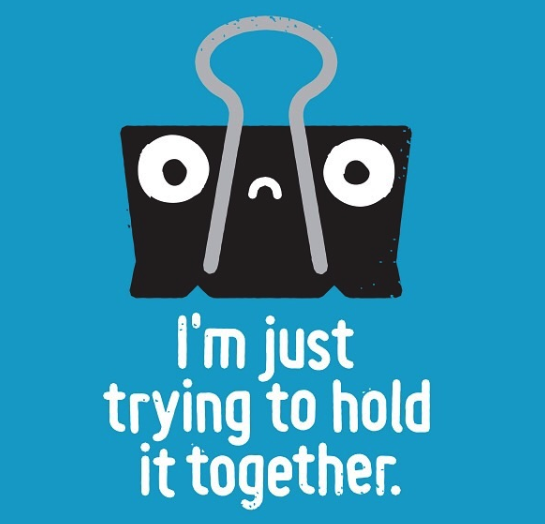
“Get A Grip” by David Olenick
Then of course there’s another category, outside the kind of infringements that are unambiguously protected by copyright law. There are people who very clearly imitate my style & approach, and people who take my original ideas and redraw them – often repeatedly, as if they’re using my design library as a free catalog to take conceptual and visual ideas from.
It’s debatable whether legal action would be effective in these cases, but whether or not laws are being broken, It’s beyond me how they feel ok calling themselves artists. I’ve privately contacted some of them to let them know how I feel about it and to suggest that they stop, and that alone is often effective, scaring/shaming them into cutting it out.
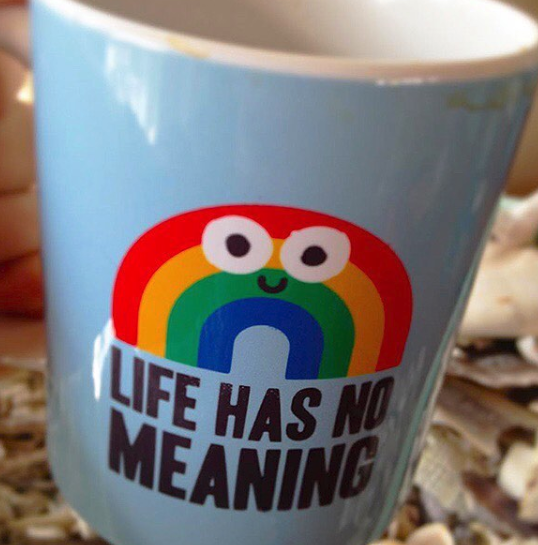
“Chaos Rains” by David Olenick
Q: What do you think is the single most important factor that has contributed to your success?
Any success I’ve had is all about my art (and certainly not any skill in business/networking/social media). I believe my art stands out because it represents an authentic (and therefore unique) point of view, both visually & conceptually.
Also, I’ve maintained a healthy, balanced artistic process, which helps me maintain a certain level of quality over time.
Q: Let’s say there’s a 16 year old kid still in school who eventually wants to do what you do. what would you tell them to do in order to get where you are?
I’d suggest they avoid putting the cart before the horse. In other words make A LOT of work, but not to sell, and not to share on social media. Just to get better and find yourself as an artist.
I think one of the benefits of the generation I’m from is that when I was in high school & college, there weren’t all these platforms to easily share or monetize your work. That meant I was able to do a ton of terrible work that no-one will ever see, experimenting and improving without the perceived pressure of an audience.
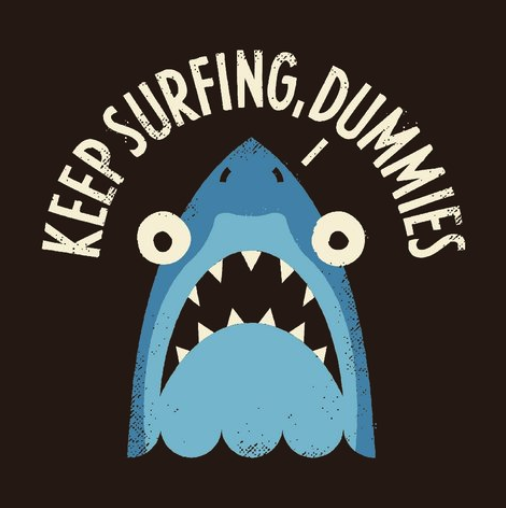
“Great White Snark” by David Olenick
Q: Do you have plans to grow your business from where it is today?
As I mentioned, I recently I started working with a licensing agent to find & handle new business. The goal here is to grow my business without having to spend a lot of time being a salesman, contract lawyer, or anything other than an artist.
Q: What do you wish someone had told you about the business of art?
I wish I’d had a better understanding of contracts early on – not just to get good royalty rates, but to know how to spot unfair & unnecessary rights-grabs.
One advantage to working with an agent now is that I can learn from their expertise. Not to mention the fact that they’ve been able clean up some of the messes I’d created.
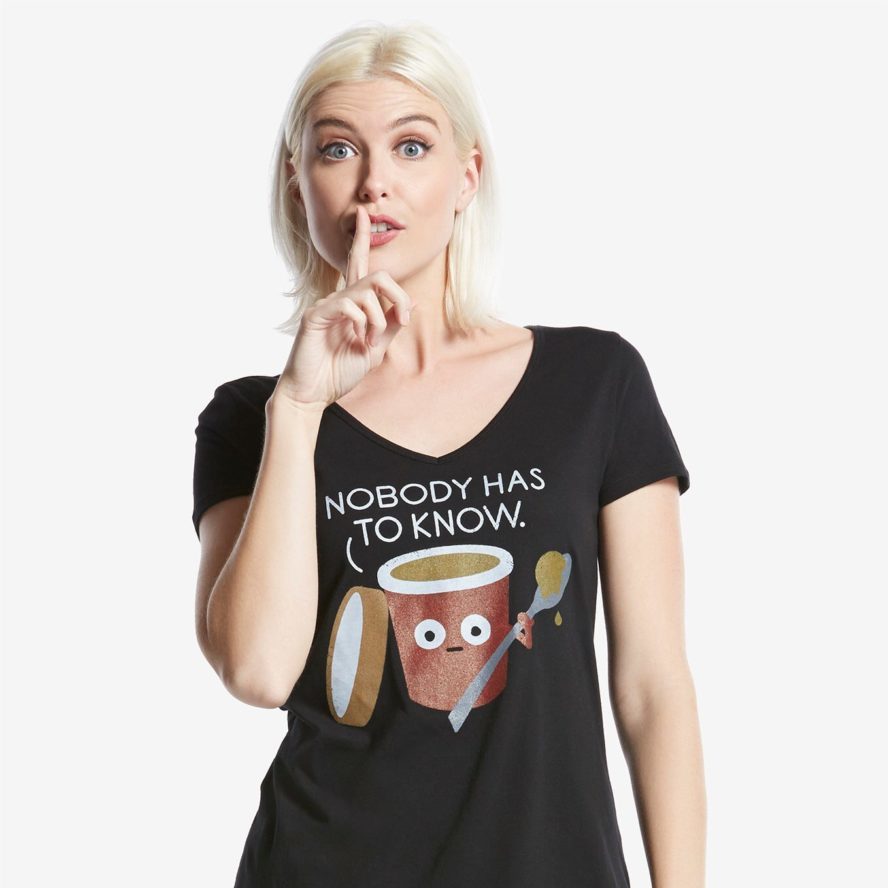
Q: Any big mistakes that you made, business or careers wise?
I’m on social media now [Instagram, Facebook], but I was very resistant to doing it early on. I’m a bit of a hermit and a luddite (I had a flip phone till early 2016). So when I had my earliest and biggest viral moment, I didn’t have a Facebook or an Instagram account to benefit from/capitalize on what was happening.
It’s not fun to think about how big my following would be if I’d done that correctly, and what that might have meant for my career.
I also got into a few really bad contracts. I’m very lucky that my ignorance early on only ended up resulting in some later inconvenience (as opposed to real damage to my ability to make a living, which could have easily happened).
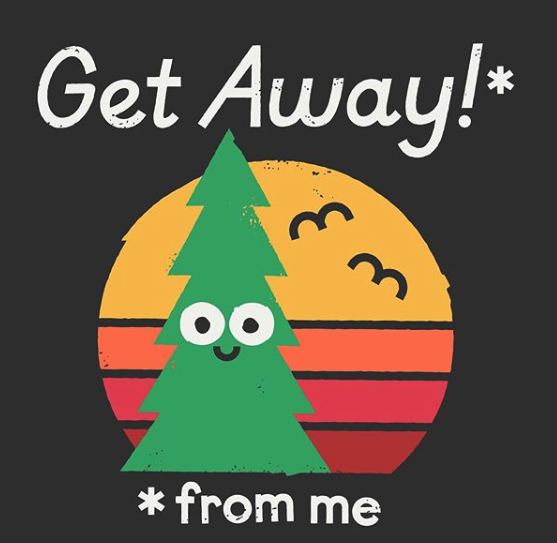
“Take A Hike” by David Olenick
Q: What do you think the future holds for independent artists and designers?
I see 3 major things that will affect the way things go for independent artists in the near future:
- 1. Print-On-Demand: I have very mixed feelings about POD. On one hand, it was what enabled me to make a living doing my own thing at the beginning. On the other hand, I’m not a fan of:
a) the cheapening effect that massive amounts of content have on any individual design/product
b) the lower quality products relative to traditional manufacturing
c) the fact that everything’s automated and you have limited control of scale/placement/color, without any human professionals putting eyes on things in a meaningful way for quality control.
Will POD usurp traditionally manufactured products, with online giants wiping out brick & mortar stores, or will there be a backlash in the other direction? Or somewhere in between?
If you focus on POD, you risk a slowly diminishing share of the pie as these sites grow exponentially. If you focus on brick & mortar, you risk disappearing stores & opportunities. So for myself I feel like I need to be doing all of it to some extent right now, and stay diversified and flexible.
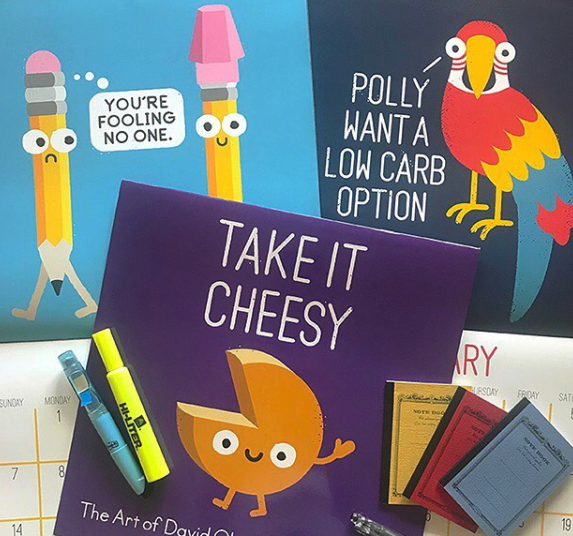
The Art Of David Olenick Calendar 2019
- 2. IP: One effect of the growth of POD (and of the internet) is that it will be both more important & more difficult to protect your intellectual property. I’m aware of some tools that are being developed to that purpose, but I only expect it to become a bigger and more unpleasant thing to contend with going forward.
- 3. Health Care: In the US where I live, the 2020 elections could lead to an expanded Affordable Care Act, universal health care, or something in between, removing a huge hurdle for people who want to be out on their own as opposed to at a day job. Or, the elections could lead to a gutting or repeal of the ACA, which would be a dangerous situation for us. As independent artists, we’re in a position to vote for outcomes that are to our benefit.
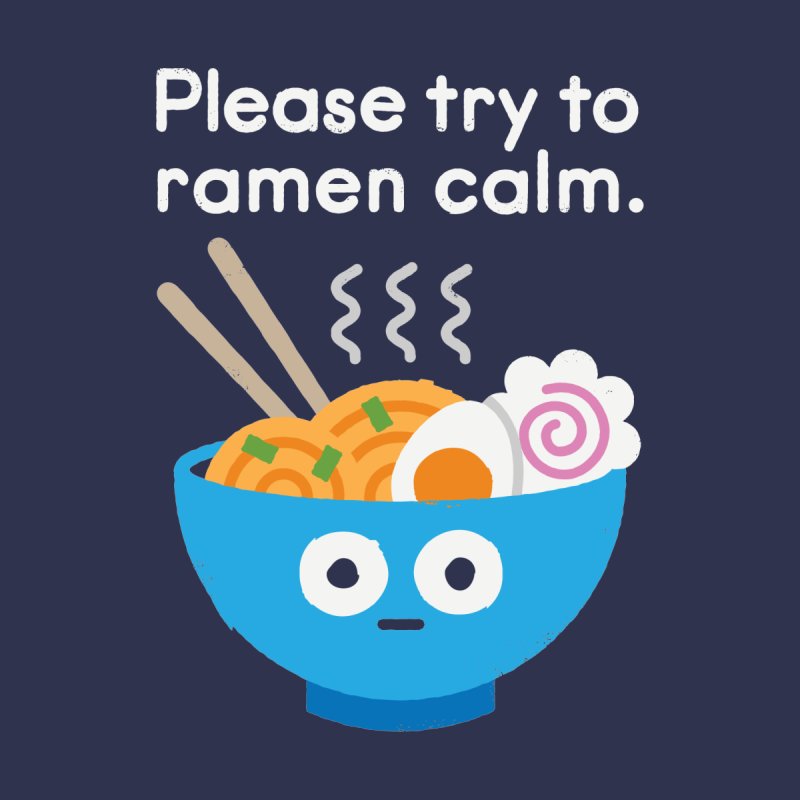
“Attention Hotheads” By David Olenick
Q: Any other advice you would give to aspiring designers? books, resources etc?
I’d advise aspiring designers to think about why you’re choosing that career, and let that guide your conduct. Think about art first, then commerce second. The commerce won’t work if the art isn’t great, and if the commerce is your priority, there are better ways than art to address it.
Yes, get “The Graphic Artists Guild Handbook: Pricing & Ethical Guidelines”, use Google to research contract terms, and read up about ways to promote yourself effectively & professionally. But give equal time to art monographs and museum visits that will make you better at your primary job function. Don’t lose sight of why we choose design – To make a life doing what we love.
My Takeaways…
My thanks to David for such detailed and insightful answers!
Here’s a few things that stood out to me…
-
Brick and Mortar (or ‘offline’) licensing is a more stable, more predictable path to long term growth. It isn’t fast growth like some people achieve via POD – but it is a house built on something a little more rock-like and a little less sand-like. For artists with an eye on the long view – start learning and thinking about offline licensing now.
-
Using Trends – not chasing them. David doesn’t jump on trends for the sake of it, but only when it makes sense to do so (i.e – he has a design he can bump up to the top). It takes a confidence in your work and years of experience to build a business on such a strategy, but artists like David are proof it can be done.
-
Quality over Quantity. David has a smaller design catalog than most of the other artists I’ve interviewed, but probably the most consistent, recognisable style of them all. You can see from his work and his methods that he treats each piece with care and doesn’t rush anything. They may be silly pun designs purchased as impulse buys – but it often takes a lot of work to create something that customers can both see, like and buy in such quick succession.
-
Consistent Style. David’s style is instantly recognisable, which has allowed him to build a consistent brand familiar to customers, licensees and retailers alike. Over time that’s an asset that protects you from your competition, because copycats and imitators won’t have that established relationship.
-
Online To Offline. David’s art licensing business started online, which boosted his reach and visibility, and then led to offline licensing deals thanks to people reaching out. The internet allows you to get visibility and attention you couldn’t achieve in years of offline effort. Ironically, one of the best ways to land offline licensing deals may be to focus on your online reach – because it attracts the attention of potential offline licensing partners.
-
Emotion in Design. David highlights that all his bestsellers combine 2 emotions – the funny and the poignant. It’s also my experience that designs with multi-level, multi-meaning jokes (designs that touch a lot of different ‘hit points’) – tend to do the best – because they have an increased reach and chance of appealing to more people.
-
POD + Offline. Artists who want to maximise their earnings over the long term should straddle the worlds of POD and offline licensing – because too much focus on one means missing out on the benefits of the other.
-
IP issues. You can almost feel the anger in David’s answers about this – copycats and infringement seem to be the biggest issue affecting independent artists right now. To me it seems there’s another artist copyright infringement story ever other day. It feels like the pressure for change is building…and personally I think that pressure should be focused on the sales platforms and supporting infrastructure (the printing facilities) – but I honestly don’t think that the solution to this problem is arriving anytime in the near future.
Thanks again to David for taking the time to answer my questions – please check out the links below to see more of his work, follow him on social media and buy yourself something neat from his stores.
Thanks for reading!
Davids Stores:
You should also go check out Davids:
More Interviews with David
More T-Shirt Artist Interviews:
If you enjoyed this article, you can find more of my artist interviews below:
For alerts about future artist interviews, you can subscribe to my weekly newsletter here.
And if you have a suggestion for an artist I should interview, please send me a message.

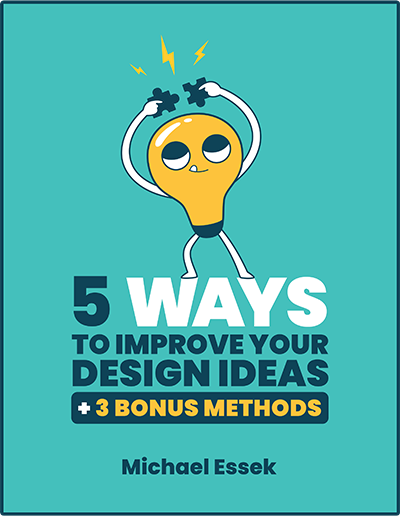

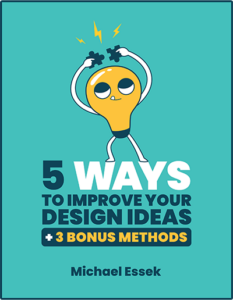

Great interview and what a cool journey. I absolutely love your designs!
Spot on! Great interview
Great interview. Thanks for sharing your insight!
This was so inspiring. Thank you both so much. Great interview.
Wow, one of the most interesting interviews i’ve ever read. Well done Michael and David!
Great info, his story was informative and inspirational!
Great information, so different than what is being “sold” in the POD space. I burst out laughing at some of the designs, what awesome creativity. Thank you both for sharing your knowledge.
What a great read with lots of information from a sympathic and professional designer. Many thanks for that!
Awesome interview, his designs are hilarious!
Awesome info…
Thanks Michael and David for sharing:)
I enjoyed reading and getting a lot of valuable information from this interview. It helped me to be inspired again to create new works and ideas.